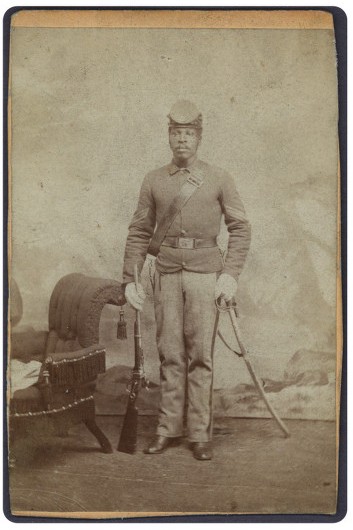By an act of Congress, the all-African American 10th U.S. Cavalry regiment (along with four other regiments stationed elsewhere in the West) is formed at Fort Leavenworth, Kansas, in connection with what are collectively known as the Indian Wars. Although blacks have served in all U.S. wars since the American Revolution itself, it marks the first time that they serve in the Regular Army. On August 7, 1867, the regiment completes a transfer to Fort Riley, Kansas. Serving under white officers, the 10th Cavalry distinguishes itself in numerous battles in Kansas and Indian Territory (present-day Oklahoma) through 1875, when the regiment is transferred to Fort Concho, Texas.
In this time, the regiment receives the nickname "Buffalo Soldiers," presumably from an incident wherein 70 Cheyenne warriors attack two civilian hunters and a sole black soldier, Private John Randall, in September 1867. While the two civilians are killed, Randall manages to ward off the attack, surviving multiple wounds and killing 13 Cheyenne. According to legend, the Cheyenne are the first to spread the word of "Buffalo Soldiers," likening black soldiers to American bison due to their ferocity, endurance, dark complexion, and thick curly hair. The 10th Cavalry and other black regiments (including the 9th Cavalry, the 24th Infantry, and the 25th Infantry) adopt the moniker as a badge of honor.
Besides the Indian Wars, the 10th Cavalry goes on to play important roles in the Spanish-American War, the Philippine-American War, the Mexican Expedition, and World War II, before being disbanded in 1944. In 1958, well after the desegregation of the armed forces, the 10th Cavalry is reactivated as a racially integrated unit, but today it uses a buffalo patch in reference to its historical roots.


